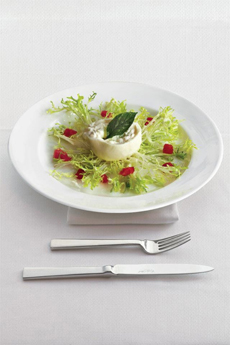TIP OF THE DAY: Frisée Salad With Lardons (Salade Frisée Aux Lardons)
|
One of our favorite salad greens, not served often enough in the U.S., is frisée (free-ZAY), curly endive that’s a member of the chicory family. In France, it is formally known as chicorée frisée. (See the different types of endive.) There are many ways to serve a salade frisée, but a universal favorite is frisée aux lardons, Lyonnaise-style frisée salad. This salad tops the frisée with a poached egg and lardons—crisp, browned chunks of pork belly—and a sherry vinaigrette. When you cut into it, the runny egg yolk gives the salad a wonderful, silky coat. Another favorite variation includes crumbled Roquefort cheese or goat cheese with a fan-sliced pear and a few toasted walnut halves. It’s a great flavor layering of bitter from the frisée, salty and smoky from the lardons, sweet from the fruit and tangy vinaigrette. You can serve salade frisée as a light lunch with crusty rustic bread, as a first course, or with soup for a light dinner. |
|
|
|
GETTING CREATIVE WITH FRISÉE You can create your own signature frisée salad by adding some of these mix-and-match ingredients: Fruits, Nuts, Vegetables |
||
|
|
Proteins You can use a classic vinaigrette or a Dijon vinaigrette, but consider these special variations: |
|
|
For another special touch, warm the vinaigrette in the microwave right before dressing the salad. WHAT IS FRISÉE Frisée is a salad green with distinctive pale, very narrow, curly leaves that grow in a bush-like cluster and are feathery in appearance. The name means “curly.” Frisée is often included in mesclun and other salad mixes. It is extremely labor-intensive to grow, and therefore one of the costliest salad ingredients. For that reason, it isn’t a conventional supermarket item, but can be found at upscale markets and purveyors of fine produce. Frisée has a distinctive flavor and a delightful bitterness—less bitter than its cousins endive and radicchio. Its exotic feathery appearance has great eye appeal. Tips for using it: |
||

